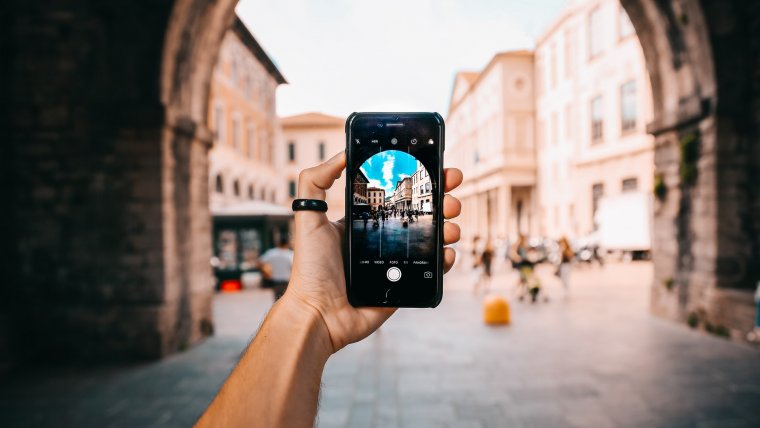
In previous articles, we’ve spoken about the advancement of photography and mobile photography in regards to what has changed and the tools that can help to improve the skills of those who want to begin. Given that there is so much to talk about and share as it regards to mobile phone photography, in the article we will be discussing the evolution of mobile photography and how to become a professional mobile photographer.
The days of photography being confined to only a set group of people have come to an end. In today’s world, as long as you have a smartphone with a camera, you’re capable of being a photographer if you want. This has inspired individuals to become travel bloggers and begin to share their story with others over social media platforms.
These social media platform not only changed the game in photography but it also changed the game in how we socialize and go about our daily lives. Social media platforms have created a bridge for creatives like myself and others to easily get to where they need to in their career. However, for us to appreciate where we are now, let’s talk a bit about where we’re coming from.
Table of Contents
Some of you might be old enough to remember some of these things and for those who have no idea, I will share some history with you. Mobile phones weren’t equipped with a camera until about the early 2000s. Back then if you had a mobile device with a camera built in if you were just about affluent and fancy. Back then the mobile phones available were shooting at about 0.11 or 0.35 megapixels. Can you imagine how much of a joke some of those images would be to smartphone photographers or bloggers now? Some if not all of these cameras were also only able to save at least 20 images and no more. So if you plan on taking some pictures on a particular day, then you better choose wisely.
As time progressed and some years past, manufacturers began to include flash on their newer model phones. I’m not sure if at this moment they could’ve been considered smartphones as yet so I will leave them at mobile phones. Things like self-timer, zoom and other features started to be added to some of these mobile cameras. However, the phone camera was still limited in what they had to offer, and most of them were stuck at just offering 1.3 megapixels which were a huge jump from just 0.11 if you ask me but this still wasn’t enough.
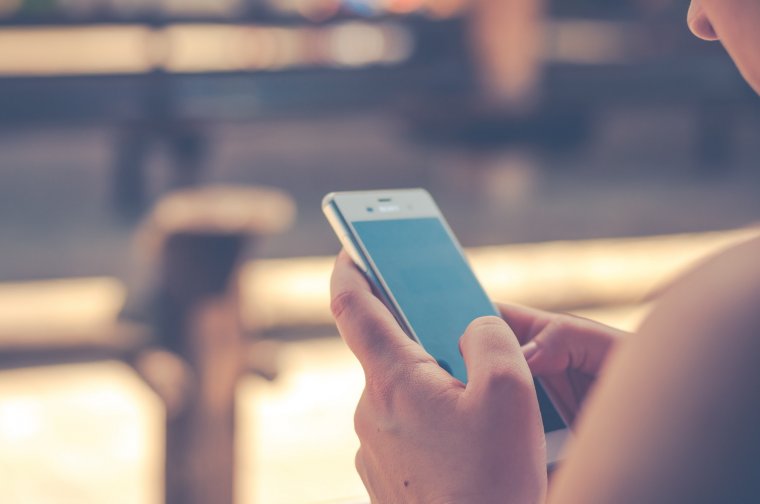
As we drew closer to late 2010 we started to see just a preview of what the future of smartphone photography and mobile phones could be. Touchscreen phones were introduced, capable of capturing video, panoramic images at more. This was a huge step for the phone camera, and it was also just in time. Pinterest made their platform available to the public in March 2010 and Instagram made their imprint on the market on the 6th of October, that same year. All of these things combined in the year 2010, changed the world of mobile photography and how we share photo and ideas forever. In addition to that, if you remember, It was around that same time that Apple released their iPhone 4.
Fast forward a few years and there have been many phone releases each year and sometime these releases consisted of 2 or more new model phones being released at once. This brought us to the age of having smartphones. We were not capable of carrying around devices that were able to be of assistance with our day to day lives in many ways other than just making a call. The cameras became more advanced and were not able to not only capture better quality images but record amazing videos as well. This encouraged a lot of individuals to invest in a good enough smartphone to now make use of all the platforms and technology now available at their fingertips.
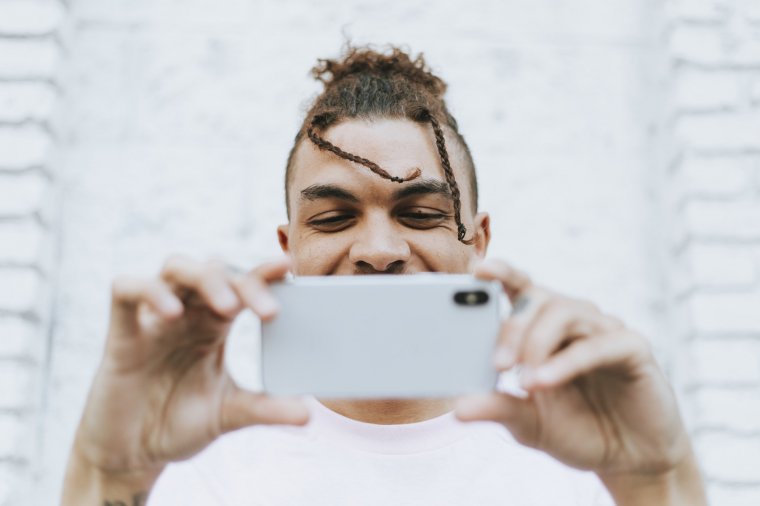
Today, we have phone cameras that are capable of shooting a minimum of 12 megapixels and capture video at a stunning 4k video quality, easily. Not to mention the storage capacity we now have is unparalleled and only makes it more exciting to see what’s to come in the future. The evolution of smartphone photography has been nothing short of amazing and gives you a different perspective on how far we’ve come and where we are going. Amazing smartphones along with amazing apps have shaped how we do mobile photography today and more than likely will continue to do so tomorrow as we grow to appreciate it.
We have realized that all the articles we have written linked to our action field, mobile photography, had always started with a real fact; most of the people in the world have access to a mobile device and many of them want to get the greatest benefit they can of those terminal cameras.
The professionalization of mobile photography is still a slow process. The half-inch format, as we call it in @fotoensayo, is the most useful camera format, but is also the one that many professionals less use in their work, even being below of some others you could think are being deprecated like the plates.
Beyond the inherent fear that we talked about in the article: the birth of the half-inch format, the reason for this is also the impossibility of migrating the workflow you get with a photographic camera to a mobile phone.

We have seen cases of photographers who use their mobiles for doing street photography, author photography and even some graphic reporter. But the studios, and in general, all the types of photography that are simply a photo montage (fashion, products, publicity) are the ones who haven’t explored smartphone photography as much.
Being that said, we took the task of thinking what would be necessary to create a photo studio, with the intention of using phone cameras in it, and of course, getting satisfactory results.
In the first place you have to consider, that the characteristics for making this kind of space are the same that you think for the mobile phone you will use. You must think that most of the phones can be used in manual mode nowadays so it will function as a photographic camera would, except for the fact of the diminished capacity of noise reduction in high ISOs, a fixed diaphragm and the impossibility of being able to synchronize the flash with the obturation.
Therefore, we must look after phones which diaphragm values are over 2.0, in this way we will guarantee a considerable light entrance; and if it is possible, look also that the dispositive can take DNG format photos, this will help at the moment of the revealing and finally, it must have a camera application that let you modify the ISO, shutter speed and white balance as minimum. Also, it will be appreciated if you can use focus in the manual mode, as you could find low lights situations that won’t let you focus easily in automatic mode.
When talking about photography we tend to forget the etymology of the suffix “photo”, which means light. In consequence, the first aspect we ought to understand is the role of lighting conditions for any kind of scenes.
What truly happened? Why is the concept of light being forgotten? There’s no clear answer on this behalf; technological developments have taken the route of building cameras capable enough to make quality photos in almost any light condition. In this sense, light is commonly seen as a sort of background plane that gives homogeneity to photograph, which, in turn, results in the absence of space for creativity and aesthetics differences. Because of this, and before we start to discuss specific topics in professional photography, we want to invite each reader to understand the way the light affects their photos and how mastering this knowledge proves to be a significant improvement in their work.
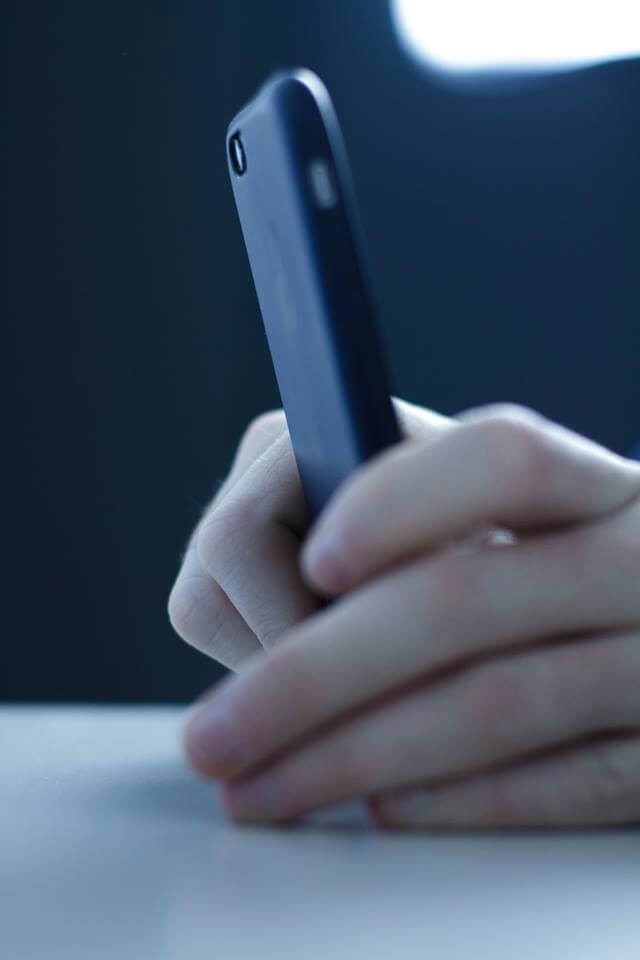
In the first place, we would like to expose the reasons why understanding how light works take such important role in mobile photography. Different from any other digital medium, mobile phones cameras have very small sensors that do not allow a broad capacity of light capture. And as we will see, if we do not look for more options to balance this situation, the result will be a better photo with very luminous areas – often labeled as “burnt”- full of noise, lacking definition in random areas of the image.
So, how does the light work? The scene’s light is directly related to the location of the light source respect to the portrayed object and the camera. As this is the first element that needs to be defined, the question should be: Where is the light source coming from? We will refer to this as light direction.
According to the light direction, we can easily label them according to their function: backlight, fill light, key light, natural light; but also acknowledge the feeling the photographer wanted to give to the composition since different illumination conditions translate into different feelings.
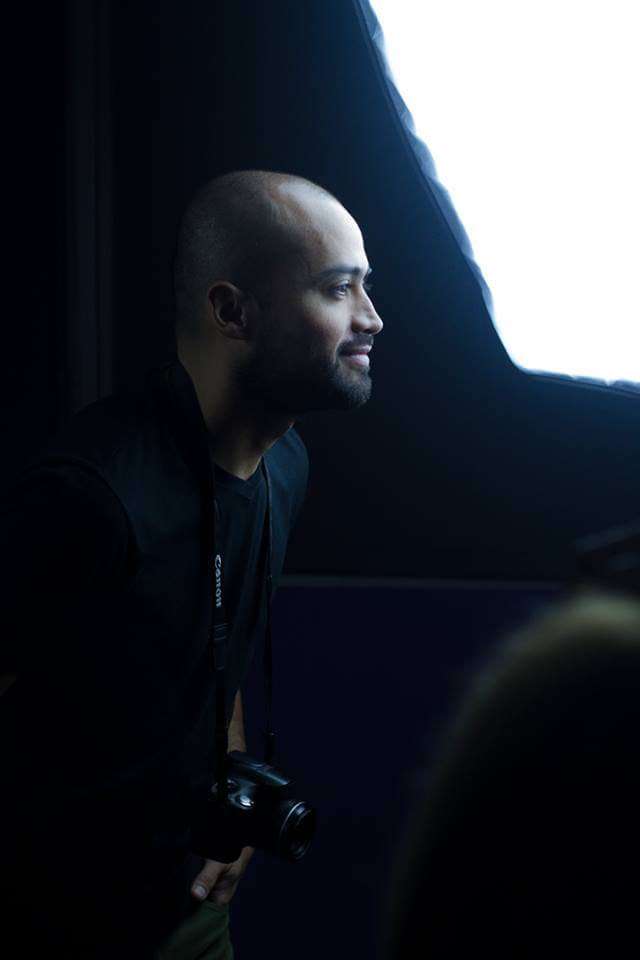
Next element to consider is the light intensity. This has a fundamental role when talking about mobile photography tips If it is true that light direction refers to the location of this light respect to the object, the intensity directly refers to the distance between the object and the light. So, less distance between object and natural light, more light intensity as a result.
We have realized that all the articles we have written linked to our action field, mobile photography, had always started with a real fact; most of the people in the world have access to mobile phones and many of them want to get the greatest benefit they can of those terminal cameras.
The professionalization of this type of photography nowadays is still a slow process. The half-inch format, as we call it in @fotoensayo, is the most useful camera format, but is also the one that many professionals less use in their work, even being below of some others you could think are being deprecated like the plates.
Beyond the inherent fear that we talked about in the article: the birth of the half-inch format, the reason for this is also the impossibility of migrating the workflow you get with a photographic camera to a mobile phone.

We have seen cases of photographers who use their mobiles for doing street photography, author photography and even some graphic reporter. But the studios, and in general, all the types of photography that simply a photo montage (fashion, products, publicity, travel photography) are the ones who have less explored this kind of support.
Being that said, we took the task of thinking what would be necessary to create a photo studio, with the intention of using mobile phones in it, and of course, getting satisfactory results.
In the first place you have to consider, that the characteristics for making this kind of space are the same that you think for the mobile phone you will use. You must think that most of the phones can be used in manual mode nowadays so it will function as a photographic camera would, except for the fact of the diminished capacity of noise reduction in high ISOs, a fixed diaphragm and the impossibility of being able to synchronize the flash with the obturation.
Therefore, we must look after phones which diaphragm values are over 2.0, in this way we will guarantee a considerable light entrance; and if it is possible, look also that the dispositive can take DNG format photos, this will help at the moment of the revealing and finally, it must have a camera application that let you modify the ISO, shutter speed and white balance as minimum. Also, it will be appreciated if you can use focus in the manual mode, as you could find low lights situations that won’t let you focus easily in automatic mode.
As for us, we use the LG L5, that has good performance in low light conditions and it also counts with two focal lenses; one of them is angular which makes work much easier in reduced spaces.

Now that we have chosen the mobile phone, that, of course, it will always be the one you have in that moment, you can change it as long as it is of your interest, the next thing is the illumination.
The studio idea is that you can guarantee punctual light conditions, this is why we will look light sources that can be useful for this so we will only use continuous lights: As we already know, there are many different light types: tungsten, led, dichroic, in resistance…but the idea is to look after those who warm up as little as possible, having a power over to 100 W (remember that more power, more light intensity and hence less noise in the produced images) and amplitude in the light sources distribution.
About this last consideration, usually it is not taken into account by the photographers but when the light a very small point, it is hard to make it smooth and uniform. So then we recommend that if you are going to use small lights sources, use two with direction variations at least.
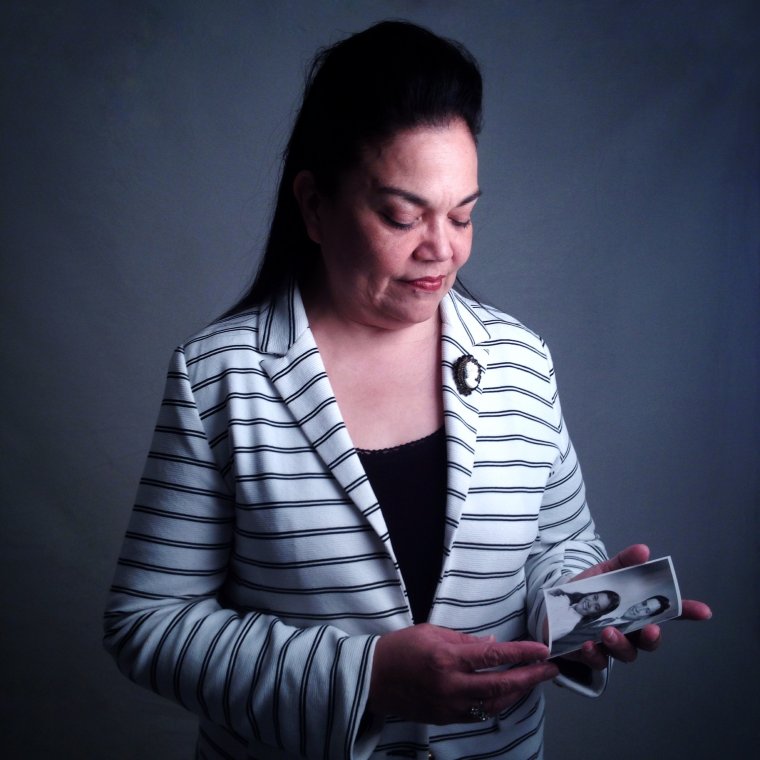
You can find several options of lamps, tungsten light bulbs with their respective diffuser and base on the internet for less than 100 euros. Either way, there will always be the possibility of designing your own system according to your specific needs. In the past, we even use tablets and some other mobile phones as light sources for portraits and small scenes with very good results.
A relevant element at the moment of the acquisition of lights will be your diffuser. Mobile phones do not have a very wide dynamic range and the difference between light and shadows zones can be very notable with barely medium zones. There before, for having information about those zones, whenever is required the diffuser is fundamental.
With a couple of these dim lights, your mobile phone and a background of your choice you will have a studio for to create a better photo.

After all, it may sound like a lot of work to do, but talking about quality your mobile phone photos will have a more elaborate aesthetics and as for the cost, there is nothing else to say, you will have a studio for a really low cost.
Then you can complement it with some other elements like additional lights, different backgrounds, some clothing, decoration objects, photographic printers for mobiles and anything else.

Why is light so fundamental in the mobile photography world? It is mainly because the light intensity determines the quality of the image. Generally, in the photos where there is a broad distance between the light source and the object, the light incidence in the object is minimal; this ends up becoming an effort of some part of the camera elements such as the shutter speed or ISO to achieve visible images, but the fact is, it will generate excess of grain or it will give a blurred aspect.
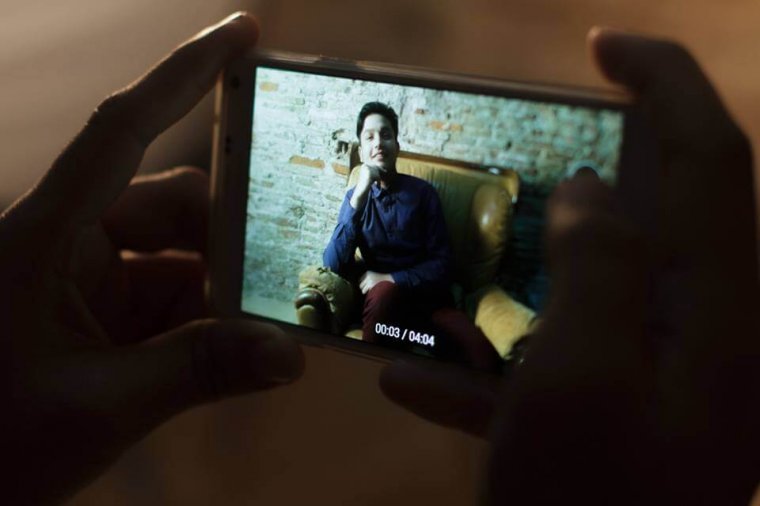
Because of this, one of the secrets for mobile photography is to shoot with continuous light, flashlights, lamps, etc. As light sources bring the object as close as it is possible to the light emitter, it will immediately produce an increment in the quality of the image produced by a mobile phone. At this point, as we imagine, there must be a lot of questions arising in you, such as: what happens with the shadows in situations where the subject is close-by to the light emitter? Or: what happens with the sun? whose conditions we cannot alter. We will try to answer this hypothetical cases, and we will extend the invitation to give us your comments or doubts about this.
Starting with the first hypothetical situation, it is true that the closing up the distance of the object to the light source will generate prominent shadows; in this case, if you are looking to get more light in these areas, the solution could be using a light source that countervails the shadows or also move away, a little bit, the object from the light, always considering the relation: more distance, less intensity equal to low quality.
The second situation is natural, we can not get closer to the sun, but as this is such a powerful light source that generates enough intensity by just being in direct contact with it; hence, there’s no need to implement more light sources for our mobile phone to boost the quality of the image. In this case, we would recommend studying with care the light direction as natural illumination conditions tend to quickly change depending on the hour in which we are working outside.
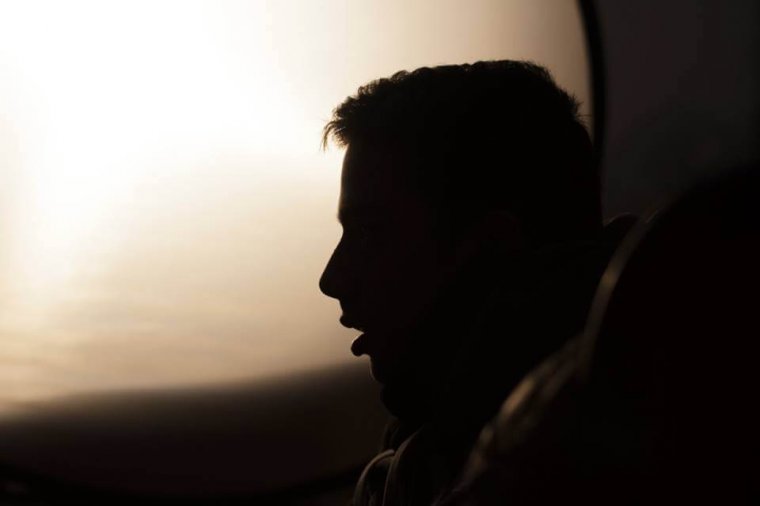
Finally, the last element that will allow us to understand the light will be the temperature of it. It’s all about the energy emitted by its wave spectrum, and we can quickly classify it in warm and cold values. Under most cases, the mobile phones have activated the white balance compensation under the automatic camera mode. Our suggestion is to always check the current white balance values for the smartphone camera app, as though this can be altered later on via post production software, it’s best to work directly with the mobile phone itself and not lose quality in the process.
Considering these three elements direction, intensity and temperature your mobile phone photos will improve not just in quality but in creativity aspects. Remember that light is the base of the photography, understanding it is fundamental if you want to become a better photographer.
Now that we’ve covered some important questions regarding the role of mobile photography in the photography world; it’s just natural to assume that the next step would be to analyze all those elements that make us become professional mobile photographers.
We’re talking about a brand new branch of photography itself, with probably a not so long lifespan before it experiments any significant role change due to the constant rate in which mobile phones are being upgraded, though for us it’s important to acknowledge the universality of these devices up to this date.
Yet, for the clients, a photographer is the one who ought to have a good light and camera set in order to be a professional. They associate the terms of professional work with the gear to use, mostly the size of them and in the complexity of their use.
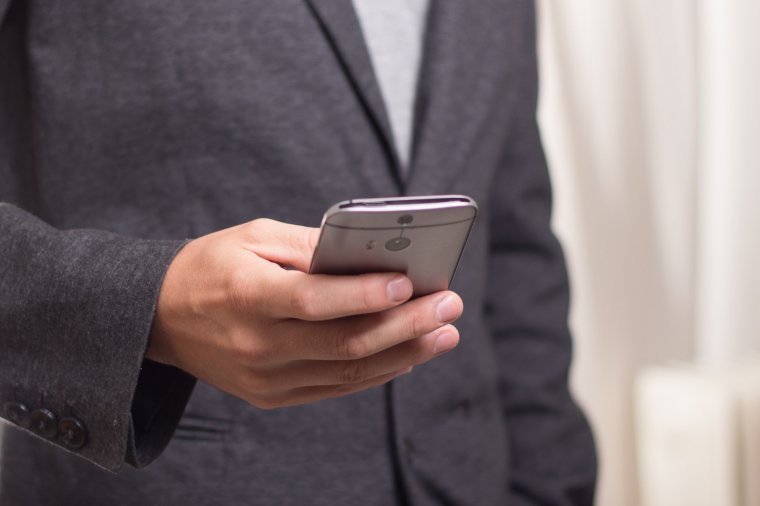
Regardless all this, not all is bad. In the competitive photographic world, the defeatist position is non-acceptable. Besides, after a better analysis, you could find out that mobile photography does have advantages that make it a viable option in the professional area.
For example, it is to consider that the mobile phone characteristics may not be able to compete with some other digital photographic mediums in terms such as max image output, adverse light conditions or detail enhancement; but if we are talking in terms of the portability, the possibility of sharing our work directly from the unit, or the vast range of tools to use, mobile photography seems to be the so called “winner”.
In marketing, talking about competition levels of some markets invokes two concepts for acknowledging the competitive level: the red and blue oceans, the first ones refer to those highly competitive markets; in which sharks are always at the ready to ambush, or as it can be commonly labeled, the voracious competition. The blue ones, on the contrary, are barely competitive markets, usually addressed by innovative people.
So well, our first invitation, for all those who are looking to advocate for the mobile phone professional use as a photographic tool, will be to look all these diverse factors and convert them into services that can be offered to the public and generate interest by it.
Furthermore, let’s do not forget mobile phones have a less margin inversion and maintenance than other photographic services so, making this investment more cost-effective in long term.
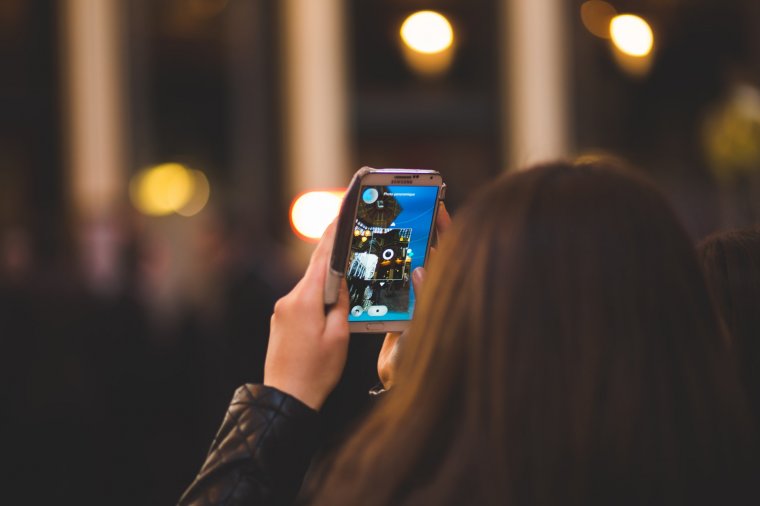
Another element to consider at the moment of thing in a mobile phone as a professional photographic tool is the big number of brands that produce them and their interest in using your work as part of their brand. Unlike conventional photography, where you can use a hand to count the camera brands that actually compete, in mobile phones world exists over 70 different brands developing this kind of devices, of which more than half of them are in direct competition with others. Regardless of this, the idea of getting sponsorship or agreements that help in a direction from the smartphone photographers and their name as a personal brand is undoubtedly attractive.
Considering all this, the option of offering unique services becomes real in a highly competitive market that constantly reinvents themselves. Although, you need to keep in mind that professionalism won’t come by the hand of high-end gear but your skills as a professional.
We can find a lot of articles around the internet questioning what photographers use to carry in their backpacks. This type of publications, usually curious and striking, allow beginning photographers to know about the technical methodology and the type of tools experimented photographers use.
Often, this type of article is accompanied by a great photo where we can appreciate the backpack surrounded by photographic tools which the photographer counts with. Apparently, this goes along the lines of “the more, the merrier”, translating into the more quantity of tools to use, the better the photos will be, at least this is how they try to make it look like. If we want to quickly resume the cliche of these posts, consider by two or three different focal distances lenses, one or two camera bodies, some notebooks, battery chargers and even drones.
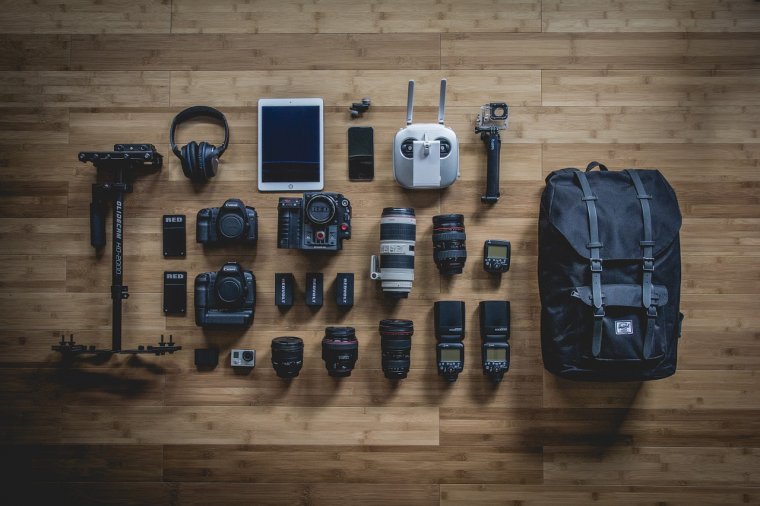
In all honesty, have you ever asked what does a mobile photographer’s backpack need to have?. We have asked some “professional” mobile photographers about this idea, and most do not even use a backpack. Having their pants pockets a little baggy for counting with enough space for their tools is more than sufficient.
Nevertheless, we wanted to gather more information and find some alternatives so, we will then show you the wider tool system that we found, so you can have an idea of the number and type of accessories a mobile phone allows, to complement the work you currently do.
It is worth to highlight that it’s not always necessary to carry all this, as we said, most of it is really far if the classic journal photographer who carries a harness full of lenses and camera bodies. Although, knowing the different tools will allow readers understand how do they work, and maybe, include one of this devices into their work tools.
First of all, and obviously, the mobile phone itself won’t be the principal item to carry in our backpack. It’s true that some people like to carry a spare camera body in case something happens, and same rules can be applied to mobile phones, although there’s no need to do such thing if we have plenty battery life to do our trip. If I would recommend packing something, the first thing would be a power bank with a USB cable to charge your device.

Some other photographers use to accompany their mobile phones with other devices as tablets which allow them to have more complex photo editing tools, which are also alternative light sources. Speaking of light sources, it exists many different sizes and types of led lamps that can be used as alternatives light sources. Let’s remember mobile phones use a led light as a flash, which is very limited and the possibility of synchronizing the mobile phones with flashes is almost null. So the led light is a very good option to help in those adverse light situations.
Generally, mobile phones are coated for different types of covers. We will find the most used are the super resistant made for protecting mobile phones of hits or to water immersion the ones who are used as chargers and the ones who can get additional lenses adapted.
Speaking of lenses, which is a very common type of accessory, we can find some interesting sets of three lenses: an angular, a fish eye and a macro. Plus, they can be complemented with a telephoto lens that allows having a closeness sensation, although these latter ones are usually of low quality. Their definition is relative and always depend on the brand that produced them.
Lastly, there are many different elements to use as tripods and little movement generators. Tripods, as in their camera version can be found in a wide range of materials – it’s common to see the gorilla types due to the possibility of mold bars and anchor it to meet up with the needs of our adventures. As to the movement generators, this little wheel supports are used to make fluent movements during the videos.
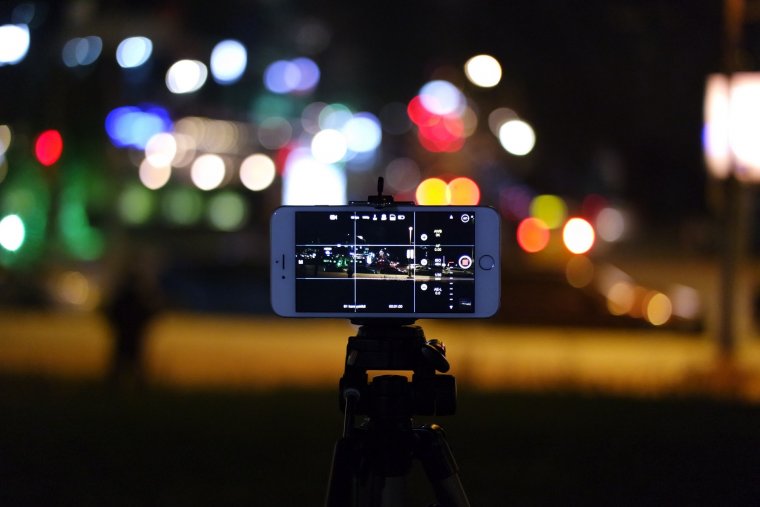
Surely we can find a good bunch of interesting accessories to boost our performance when working with mobile photography. Rest assured that you can work without these tools mentioned above, though they can make your life easier.
We are now in the age where photography or becoming a photographer is so easily accessible that pretty much anyone can become one. Of course, I say this not only with a proud voice but also honored to be a part of this cherished community. Technology over the years, as well as social media, has made its impact on the field of photography and will more than likely continue to do so for many years to come. As camera manufacturer giants such as Canon, Sony, and Nikon make improvements to their DSLR and mirrorless cameras, so are companies such as Apple and Samsung doing the same with their mobile phones.
Mobile phones are beginning to be equipped with some of the same specs built into these cameras that cost thousands of dollar. For example, you will notice that more mobile phones are able to shoot in 4k quality with impressive results. Not to mention the capability they now have in with shooting photos in low light photography. This motivates a lot of creative like myself to leave their camera at home a few times, charge up their phone and go out to test its capabilities. In this article, I will be talking to you just a bit about the world of mobile photography and if it is a lucrative field to get involved in.
The first step in the right direction for making money from mobile photography is getting a good smartphone. With all the options on the market today, this can be a hard decision to make or if you’re like me, then you already know what you want. From my personal experience and observation over the years, I would always recommend getting an iPhone.
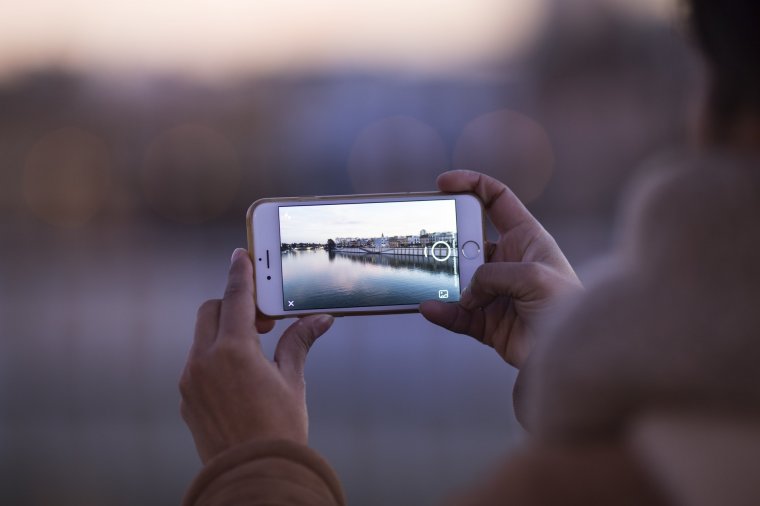
I’ve met many photographers or just individuals over all that feel a bit different about this opinion. However, if you examine the results of images taken on an iPhone camera, then you can’t deny how good it is. In some aspects, the Samsung brand of smartphones to compete with a few downfalls that Apple has but nonetheless I’ve yet to be disappointed with images quality and sharpness an iPhone camera can create. If you’re not so sure on which brand to pick, feel free to watch a few youtube reviews from some experienced photographers as they explain some of the pros and cons of each phone and more.
Now that you have a phone equipped with all the bells and whistles to get the job done, its time to explore the capabilities of your new photography tool. If you’re strictly a mobile photographer and don’t own a DSLR or mirrorless camera then this might just be a regular day for you. For those who are a professional photographer and the find the idea of leaving their camera at home completely ridiculous, I urge you to give it a try.
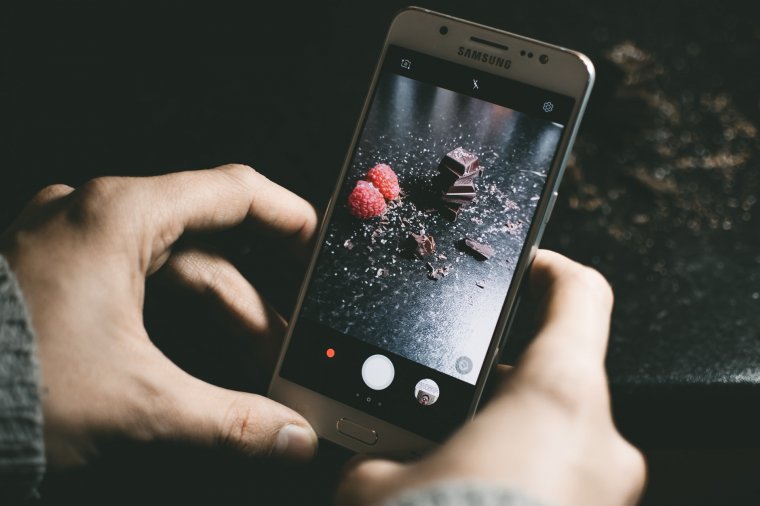
Charge up your phone and head out to make some magic. Shooting with a mobile smartphone is clearly a lot easier than shooting with a camera but it’s all about maximizing what you can do with it. Explore different setting to see what they have to offer as well as trying different perspectives during your day.
Social media platforms such as Instagram has created such a large community of users that it’s made getting the attention of a company CEO that much easier. Whatever you post on these platforms is always being viewed or liked by someone. This person might not even be in the same country as you are but yet that bridge of communication has been made through social media. Once you’d created the content you’ve created the content you wanted, its time to post and grab the attention of those you need. Of course, this is only one of the avenues as to how you can create revenue from just using the camera on your phone.
Many multimillion-dollar brands have become a fan of having constant content to post on a daily basis. These brands look forward to seeing contented created by some of their customers and other creatives. Once you’ve created some great content, the next step is to tag the company or brand that you would like to see what you’ve done and grab their attention. Uploading high-resolution images with detailed descriptions attached with keywords or hashtags that are searched often is bound to get someones attention. Once you are discovered, you can then create a relationship with different brands or companies which will then pay for these images you have created with just your phone.
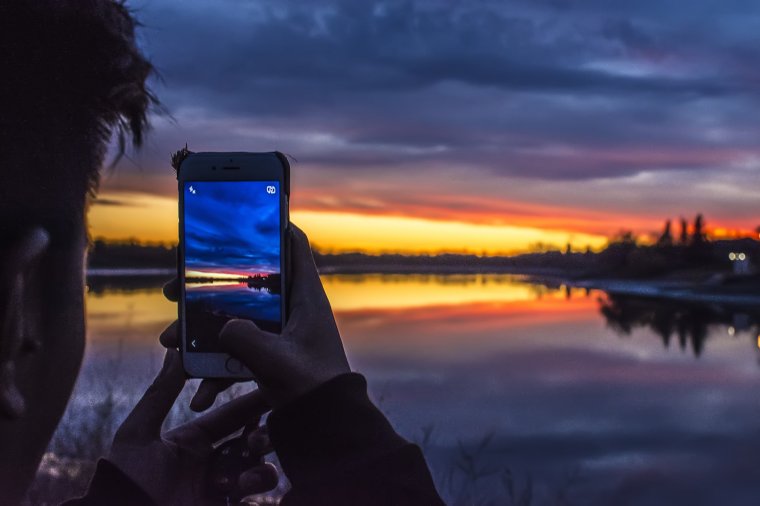
Another avenue through which you can generate revenue through the images taken on your phone is submitting your images to collectors that then seek buyers for the images you’ve submitted. There are a bunch of different communities that facilitate this online as well. You will be surprised as to how much a company or person is willing to pay for a single image you’ve taken. Explore these avenues because there is always someone out there who are looking for exactly what you’ve created.
In this day and age, mobile photography is very lucrative depending on the market you’re targeting. It is lucrative because it is still photography nonetheless and once the quality content is being created within the spectrum of what is needed, there is someone willing to pay. Photography is such a broad beautiful umbrella which encompasses many things that are beneficial to professionals and beginners today.
One of the most frequent questions crossing into a photographer’s mind, when they are starting the commercial level of this field is, precisely, how much charge for the photos. Without a doubt, this is a topic that has to make young and not so young people who decide to start in this world, worried about this.
We can come across countless articles on the “how much should I charge for…” question. Some answers happen to be better than others, for which our general advice is: do not listen to anyone who tells you an exact number of how much charge. The reason for this is that no one can know what are you usually charging for your services, therefore it won’t be the same scenario as we tend to make our price list by gauging parameters such as experience, expenses, type of services, etc.
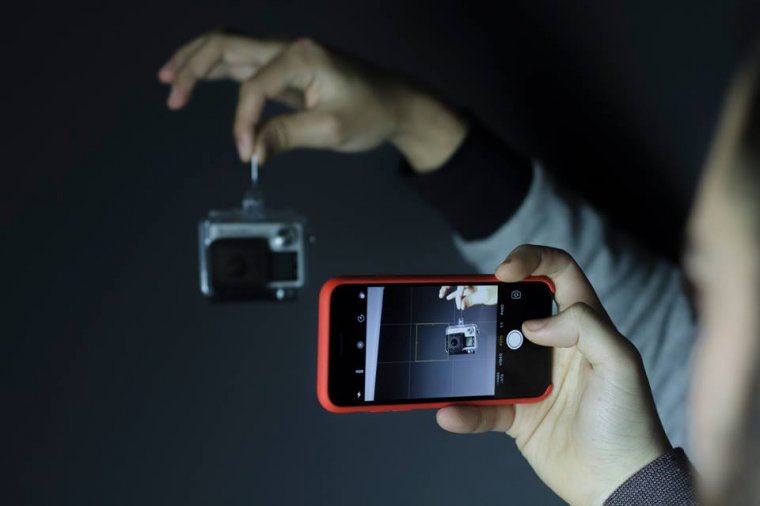
Having said this, we want to go deep into a complex topic that has not been very exposed: How much to charge for your mobile photos.
Pitifully, because of the universal availability of mobile phones and the fact that they are still not considered as professional tools for the trade, it’s quite difficult to put a label on the professional job we do with it.
The first thing to understand is that it is our duty to be completely sure about our job, regardless of the medium used, as we happen to be professionals and we are competing not just with other trained users in the market but also with amateurs. It’s among our duties to showcase the work we do, to prove clients we are trustworthy and that they can rely on our expertise.
Then, it will come the time to determinate how much our work is worth. For this, the best thing to do, in the first place, is to acknowledge a number of resources the service implies. By resources, we can say transportation fees, gear usage, time spent in doing the job, food, etc. Production team should also be considered in this equation, as despite being a mobile phone photo session we need the services of hairdressers, makeup artists, etc. Another frequent mistake beginners tend to make is the fact they assume they can cover everything, and that’s not true. If you happen to be the photographer, then do exactly as you are expected to do, and do not make the silly attempt to do the makeup, scenario setup, transport the gear, etc. just to reduce expenses in order to get a job done.
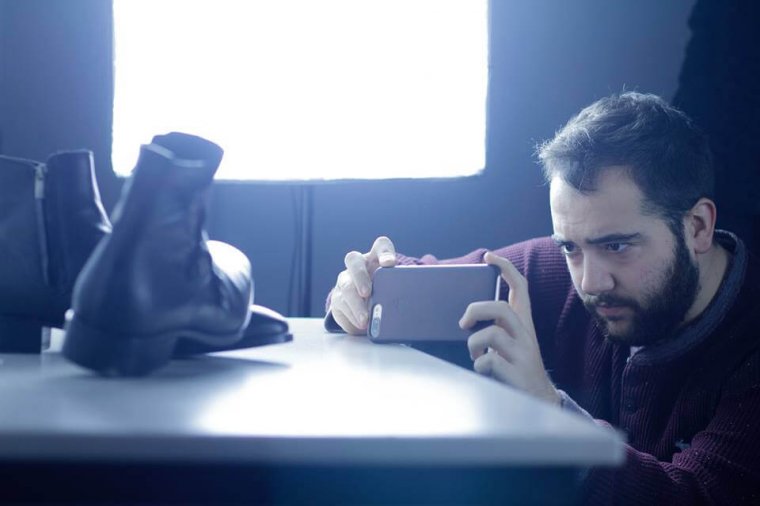
Also consider the expenses of insurance services, the potential eventuality in which your photography gear might get damaged due to an accident or negligent behavior on your behalf – yes, it’s mostly your fault, but it happened during a session. Consider these elements as a percentage, to sum up to your overall price for the service offered.
One useful tool to use is to get a grasp of what photographers associations release as basic fees for photography services, which often showcase fees per photo, fees including special setups, if they also need video files to be included with the job, etc.
Be also ready to assume that people won’t consider your work as professional quality one due to the prejudice in which smartphones are often seen not just by fellow photographers but also by common users. In case everything else does not seem to work, do a roundup among your competitors to check their current fees for services similar to the ones you desire to offer and adjust your price list with confidence.
Comments (0)
There are no comments yet.